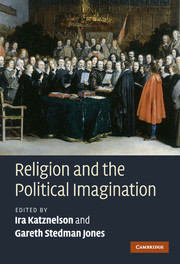Book contents
- Frontmatter
- Contents
- List of contributors
- Acknowledgements
- Introduction: multiple secularities
- 1 Secularisation: religion and the roots of innovation in the political sphere
- 2 Regarding toleration and liberalism: considerations from the Anglo-Jewish experience
- 3 The Enlightenment, the late eighteenth-century revolutions and their aftermath: the ‘secularising’ implications of Protestantism?
- 4 In the lands of the Ottomans: religion and politics
- 5 The Russian Orthodox Church and secularisation
- 6 The American experience of secularisation
- 7 French Catholic political thought from the deconfessionalisation of the state to the recognition of religious freedom
- 8 Religion and the origins of socialism
- 9 From 1848 to Christian Democracy
- 10 The disciplining of the religious conscience in nineteenth-century British politics
- 11 Colonial secularism and Islamism in North India: a relationship of creativity
- 12 The 1960s
- 13 Gendering secularisation: locating women in the transformation of British Christianity in the 1960s
- 14 Does constitutionalisation lead to secularisation?
- 15 Europe's uneasy marriage of secularism and Christianity since 1945 and the challenge of contemporary religious pluralism
- 16 On thick and thin religion: some critical reflections on secularisation theory
- Index
13 - Gendering secularisation: locating women in the transformation of British Christianity in the 1960s
Published online by Cambridge University Press: 05 June 2012
- Frontmatter
- Contents
- List of contributors
- Acknowledgements
- Introduction: multiple secularities
- 1 Secularisation: religion and the roots of innovation in the political sphere
- 2 Regarding toleration and liberalism: considerations from the Anglo-Jewish experience
- 3 The Enlightenment, the late eighteenth-century revolutions and their aftermath: the ‘secularising’ implications of Protestantism?
- 4 In the lands of the Ottomans: religion and politics
- 5 The Russian Orthodox Church and secularisation
- 6 The American experience of secularisation
- 7 French Catholic political thought from the deconfessionalisation of the state to the recognition of religious freedom
- 8 Religion and the origins of socialism
- 9 From 1848 to Christian Democracy
- 10 The disciplining of the religious conscience in nineteenth-century British politics
- 11 Colonial secularism and Islamism in North India: a relationship of creativity
- 12 The 1960s
- 13 Gendering secularisation: locating women in the transformation of British Christianity in the 1960s
- 14 Does constitutionalisation lead to secularisation?
- 15 Europe's uneasy marriage of secularism and Christianity since 1945 and the challenge of contemporary religious pluralism
- 16 On thick and thin religion: some critical reflections on secularisation theory
- Index
Summary
The marginalisation of gender
Of all the ways in which secularisation has been imagined and studied by scholars, the least explored has been gender. As a category of analysis, it is now pretty standard across the historical and sociological professions, and has transformed areas of study, established entirely new ones, and generally invigorated intellectual thought about past and present societies. But few studies of religious change and secularisation in the twentieth century have considered gender seriously. Some of those, notably by Hugh McLeod, have concluded that class remained more important than gender in differentiating people's religious behaviour. Peter van Rooden has conducted a small-scale oral-history project in the Netherlands to test the involvement of women in the 1960s in the ‘strange demise of Dutch Christianity’. This chapter explores further gendered aspects of the British experience of secularisation since the 1960s. It does this through a reading of both women's and men's autobiographies as a source revealing the transformation of the place of religion in British culture. Like any approach, this has its difficulties. The voices heard recalling mid-twentieth-century Britain tend to lean strongly towards a group of people involved in the political and cultural changes represented by the term ‘the sixties’ and its counter-culture. Many of the people who talk of the cultural transformation were participants in it, and seemed to be inhabiting a world predominantly of London and the south-east of England; the term of choice was, after all, ‘swinging London’.
- Type
- Chapter
- Information
- Religion and the Political Imagination , pp. 275 - 294Publisher: Cambridge University PressPrint publication year: 2010
- 1
- Cited by



